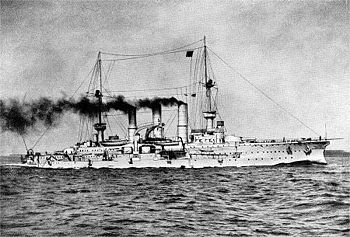SMS Friedrich Carl (1902)
|
|
|
|---|---|
 The sister ship SMS Prinz Adalbert |
|
| Class details | |
| Ship type: | Big cruiser |
| Sister ship | |
| SMS Prince Adalbert | |
| Technical specifications | |
| Length: |
|
| Width: | 19.6 m |
| Draft: | 7.3 meters |
| Displacement: |
|
| Drive: |
|
| Speed: | 20.5 kn |
| Bunker capacity: | 750 tons of coal (normal), maximum 1,630 tons |
| Action radius: | 5,000 nm at 12 kn |
| Crew: | 35 officers, 551 men |
| Armament: |
|
| Armor |
|

SMS Friedrich Carl was a large cruiser of the German Imperial Navy , the second ship of the Prinz Adalbert class . The Prinz Adalbert was planned as a replacement building for the König Wilhelm , while the Friedrich Carl was an extension building . It was named after Friedrich Karl von Prussia , a nephew of Kaiser Wilhelm I.
Construction and technical aspects
The Friedrich Carl was in 1901 with the hull number 155 at Blohm & Voss in Hamburg laid down on and ran there on 21 June 1902 by the stack . The cruiser was completed in 1903 and entered service on December 12, 1903. The construction costs amounted to 15,665,000 gold marks .
The two ships were very similar to the previously built Prinz Heinrich , but had three funnels, and the two 24-cm guns of the Prinz Heinrich were replaced by four 21-cm quick-loading guns in two twin turrets , whose rate of fire was considerably higher than that of the larger ones 24 cm guns. As with many ships of the time, the six lower casemate guns of the secondary artillery could only be used when the sea was calm. The two ships had a good ride quality, but this deteriorated noticeably as the bunker load decreased.
career
The ship accompanied Kaiser Wilhelm II on his trip to Spain and the Mediterranean on the passenger steamer König Albert from March to May 1904 and was then assigned to the fleet's reconnaissance forces. From June to August 1904 it undertook training trips to English, Dutch and Norwegian ports, followed by participation in the autumn maneuvers of the fleet in August in the North and Baltic Seas. This ended the test drives and training drives.
From March to May 1905, the Friedrich Carl served under the command of Captain Hugo von Cotzhausen as an escort for the Emperor's Mediterranean cruise on the Hamburg . The ship collided with the British liner HMS Prince George in the port of Gibraltar in April and damaged its stern. After that it was the flagship of the commander of the reconnaissance forces until April 2, 1906. The ship took part in the fleet's summer voyage to Sweden in July 1905 and in training trips in Danish waters in February 1906. From September 1906 to March 1908, the future Admiral Franz Hipper was its commandant.
On March 5, 1908, the Friedrich Carl was temporarily decommissioned to join the torpedo test command in Kiel on March 1, 1909 as a torpedo test and training ship . In the winter of 1911/12 she was used as an icebreaker in the Baltic Sea. From July 31 to August 21, 1914 she was in the shipyard for repairs. Towards the end of September 1914 she was assigned to the Baltic Sea Fleet, where she took part in various operations against the Baltic Fleet of the Russian Navy as part of the Baltic Sea Reconnaissance Group under Rear Admiral Ehler Behring , who set his flag on the Friedrich Carl . During her forays into the Gulf of Finland, she carried up to four seaplanes , which (as far as the weather permitted) took off daily for reconnaissance.
Downfall
On 16./17. November 1914 took the Friedrich Carl under Commander Loesch at a planned attack on the Russian naval base Libau part that had been vacated by the Russian Navy for the most part, however, of the German naval leadership took that as a base for British submarines should be used . On the morning of November 17 , the Friedrich Carl ran into two Russian mines about 30 nautical miles from Memel and had to be abandoned around 6:30 a.m. She capsized and sank at 7:15 a.m. Seven of their crew in the stern torpedo room were killed. The entire rest of the crew was picked up by the small cruiser SMS Augsburg . The four aircraft on board were also lost. The attack on Libau was canceled.
Trivia
In the Russian drama Admiral "from 2008, the sinking of Friedrich Carl is artistically embellished by an artillery battle with a Russian torpedo boat and the sinking after a mine hit is accelerated and dramatized by a second explosion, presumably the ammunition chambers.
Web links
literature
- Erich Gröner , Dieter Jung and Martin Maass: The German Warships 1815–1945 Volume 1 . Bernard & Graefe Verlag, Munich 1982, ISBN 3-7637-4800-8 .
- John Roberts, HC Timewell, Roger Chesneau (Eds.), Eugene M. Kolesnik (Eds.): Warships of the World 1860 to 1905 - Volume 1: Great Britain / Germany . Bernard & Graefe Verlag, Koblenz 1983, ISBN 3-7637-5402-4 .